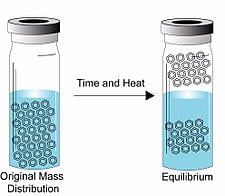When it comes to determining the level of volatile species in solid, liquid or gas samples, one of the more popular techniques is Static Headspace analysis.

Defining Headspace
Simply stated, Headspace is the gas phase or vapor portion of a sample in a sealed chromatography vial. Consumer products
and biological samples consist of compounds that differ in weight, polarity and volatility. After the sample is heated for a period of time, the solvents in the matrix volatilize. The components or compounds within the vial separate into the sample phase, which consists of a liquid or solid and a dilution solvent or matrix modifier, and then the volatile components diffuse into the gas phase.
Saving Time and Money in the Lab
In many lab environments, analysts use a variety of techniques to prepare samples and extract the important compounds from any volatile material. Oftentimes, these methods are expensive and time consuming. Static Headspace analysis eliminates this time and costs by analyzing the volatile headspace in the sealed vial. A portion of the vapor is then placed into a GC system to separate the volatile components.
Using Headspace Analysis
Although introduced in the 1960s, it has only recently become a regular technique in mainstream pharmaceutical analysis. The global application of the process is growing as a result of its success producing clean and reliable test results, particularly in analyzing alcohol levels in blood and residual solvents in pharmaceuticals.
According to Forensic Magazine, “The analysis of blood and other body fluids for alcohol is most commonly performed using headspace gas chromatography due to its simplicity and the number of samples that normally run daily. The quality of GC (gas chromatography) results depends on many factors, including the stability of the gas chromatograph, the ruggedness of the injection system, and the sensitivity of the detector. Within this process, sample preparation and introduction provide the foundation for repeatability and reliability that are essential for the generation of quality data. Robustness and easy maintenance are also paramount to ensure continuous operation.”[i]
It is also commonly used for analyzing monomers in polymers and plastics and fragrances in cosmetics, and increasingly in the flavor industries in the analysis of fruits, vegetables, meats, dairy products and beverages.
A June 2012 study by Shandong University of Technology in China validated the analysis process using fermented wheat beer.
A headspace sampling gas chromatography coupled with an internal standard method was utilized for the determination and quantification of eight volatile components in top fermented wheat beer samples in the laboratory. The technique was validated and proved to be sensitive, precise and accurate. The results obtained showed that HS-GC (Headspace sampling-gas chromatography) can be successfully used in the analysis of flavor compounds in beer, and indicate that it has the potential interest in real analytical applications. As also showed by many researchers the HS-GC is a reliable and reproducible technique.[ii]
In part 2 of The Basics of Static Headspace analysis, we’ll focus on how to achieve the best performance when using Headspace/GC, including careful attention to sample preparation and instrumentation.
Teledyne Tekmar draws on our experience as a leader in low-level VOC analysis with the HT3 and the Versa Static and Dynamic Headspace Systems.
Versa is the perfect solution for applications which require all the advantages of headspace analysis and is economical to fit any budget. Click for more information on the Versa.
Dramatic improvements in sensitivity are achieved with the HT3 Dynamic Headspace option, while maintaining the ruggedness and reliability of a traditional Static Headspace instrument. Click for more information on the HT3.
